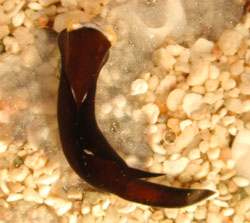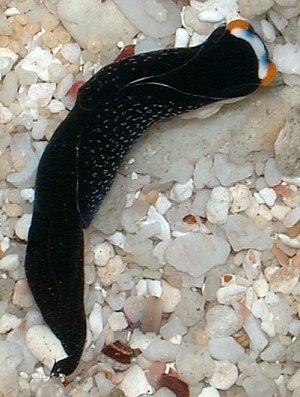Chelidonura flavolobata & C. inornata
May 31, 2003
From: Bill Rudman


PHOTOS: Upper: 'Spotted' form of C. flavolobata. Red Sea ca. 20 km south of "Quseir", May 2003. Photo: Nils Anthes. Lower: C. inornata. Christmas Island, Line Islands, eastern Kiribati, 35mm long. May 2003. Photo: Don Barclay.
Nils Anthes recent messages [message 1, message 2, message 3] raise the question of just what is the relationship between C. flavolobata from the Indian Ocean and C. inornata from the Western Pacific. Also, is Chelidonura sp. 4 from Fiji a colour variant of C. inornata?
C. flavolobata, known previously from only 2 specimens, was originally characterised by the solid yellow lobes on either side of the head and the lack of white spots anywhere. Nils's observations suggest that C. flavolobata can vary quite significantly in colour from animals which are pure black with yellow head lobes, to animals in which the yellow is restricted to a marginal band on white head lobes and with 'dense white spots around the eyes, at the edges of the parapodia and the rear end of the head shield'. In the upper photo which shows one of these 'spotted' animals, there also appears to be a white band across the front of the head. A similar band is found in C. inornata.
Looking at the messages of other animals identified as C. flavolobata, I am sure that Marina Poddubetskaia's March 2003 photo has the same colour pattern, but I can't see the head clearly enough in her earlier messages [photo 1, photo 2] to be sure.
How can we interpret this? From Nils' mating observations it would seem that C. flavolobata is much more variable in colour than earlier reports would suggest. If we compare the colour of this 'spotted' form to the colour of Chelidonura inornata then the only differences are that C. inornata has white spots on the parapodia and foot and usually the white band across the head is more prominent. The similarities though, including the orange band on the head lobes and the position of the white pigmentation on the parapodial borders is quite remarkable.
I would agree that it is probably best to consider the Pacific species and the Indian Ocean species to be separate, but we will need to enlarge the definition of C. flavolobata. However I don't know what to do with Chelidonura sp. 4, from Fiji, which seems to be a C. inornata without white specks on the parapodia, which would make it identical to the white spotted C. flavolobata from the Red Sea.
Bill Rudman
Related messages
-
Eggs of Chelidonura flavolabata
From: Lior Harari, March 29, 2007 -
Chelidonura flavolobata from the Red Sea
From: Kamal El Tawil, May 17, 2006 -
Chelidonura flavolobata - extreme close up
From: Oren Lederman, March 9, 2006 -
Re: Chelidonura flavolobata - color variation
From: Oren Lederman, March 19, 2005 -
Black Chelidonura flavolobata with white lobes
From: Oren Lederman, March 19, 2005 -
Chelidonura flavolobata - color variation
From: Oren Lederman, March 17, 2005 -
Chelidonura flavolobata from the Red Sea
From: Oren Lederman, March 9, 2005 -
Chelidonura flavolobata from Egyptian Red Sea
From: Michael Mrutzek, January 4, 2005 -
Chelidonura flavolobata from the Red Sea
From: Harro H. Quitzau, July 2, 2003 -
Chelidonura flavolobata from Red Sea [2]
From: Nils Anthes, May 31, 2003 -
Chelidonura flavolobata from Red Sea [3]
From: Nils Anthes, May 31, 2003 -
Chelidonura flavolobata from Red Sea [1]
From: Nils Anthes, May 28, 2003 -
Chelidonura flavolobata from Egypt
From: Marina Poddubetskaia, March 12, 2003 -
Re: Chelidonura flavolobata from Red Sea
From: Marina Poddubetskaia, April 21, 2002 -
Chelidonura flavolobata from Red Sea
From: Marina Poddubetskaia , April 16, 2002 -
Chelidonura flavolobata from Saudi Arabia
From: Gordon T. Smith, January 30, 2001 -
Chelidonura flavolobata from Red Sea
From: Erwin Koehler, January 22, 2001
